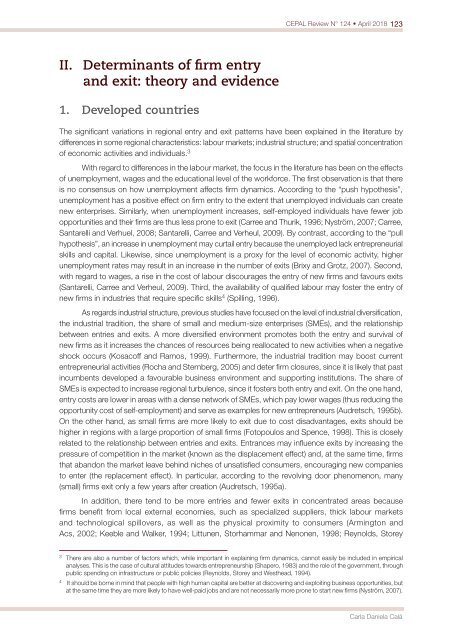CEPAL Review no. 124
April 2018
April 2018
Create successful ePaper yourself
Turn your PDF publications into a flip-book with our unique Google optimized e-Paper software.
<strong>CEPAL</strong> <strong>Review</strong> N° <strong>124</strong> • April 2018 123<br />
II. Determinants of firm entry<br />
and exit: theory and evidence<br />
1. Developed countries<br />
The significant variations in regional entry and exit patterns have been explained in the literature by<br />
differences in some regional characteristics: labour markets; industrial structure; and spatial concentration<br />
of eco<strong>no</strong>mic activities and individuals. 3<br />
With regard to differences in the labour market, the focus in the literature has been on the effects<br />
of unemployment, wages and the educational level of the workforce. The first observation is that there<br />
is <strong>no</strong> consensus on how unemployment affects firm dynamics. According to the “push hypothesis”,<br />
unemployment has a positive effect on firm entry to the extent that unemployed individuals can create<br />
new enterprises. Similarly, when unemployment increases, self-employed individuals have fewer job<br />
opportunities and their firms are thus less prone to exit (Carree and Thurik, 1996; Nyström, 2007; Carree,<br />
Santarelli and Verhuel, 2008; Santarelli, Carree and Verheul, 2009). By contrast, according to the “pull<br />
hypothesis”, an increase in unemployment may curtail entry because the unemployed lack entrepreneurial<br />
skills and capital. Likewise, since unemployment is a proxy for the level of eco<strong>no</strong>mic activity, higher<br />
unemployment rates may result in an increase in the number of exits (Brixy and Grotz, 2007). Second,<br />
with regard to wages, a rise in the cost of labour discourages the entry of new firms and favours exits<br />
(Santarelli, Carree and Verheul, 2009). Third, the availability of qualified labour may foster the entry of<br />
new firms in industries that require specific skills 4 (Spilling, 1996).<br />
As regards industrial structure, previous studies have focused on the level of industrial diversification,<br />
the industrial tradition, the share of small and medium-size enterprises (SMEs), and the relationship<br />
between entries and exits. A more diversified environment promotes both the entry and survival of<br />
new firms as it increases the chances of resources being reallocated to new activities when a negative<br />
shock occurs (Kosacoff and Ramos, 1999). Furthermore, the industrial tradition may boost current<br />
entrepreneurial activities (Rocha and Sternberg, 2005) and deter firm closures, since it is likely that past<br />
incumbents developed a favourable business environment and supporting institutions. The share of<br />
SMEs is expected to increase regional turbulence, since it fosters both entry and exit. On the one hand,<br />
entry costs are lower in areas with a dense network of SMEs, which pay lower wages (thus reducing the<br />
opportunity cost of self-employment) and serve as examples for new entrepreneurs (Audretsch, 1995b).<br />
On the other hand, as small firms are more likely to exit due to cost disadvantages, exits should be<br />
higher in regions with a large proportion of small firms (Fotopoulos and Spence, 1998). This is closely<br />
related to the relationship between entries and exits. Entrances may influence exits by increasing the<br />
pressure of competition in the market (k<strong>no</strong>wn as the displacement effect) and, at the same time, firms<br />
that abandon the market leave behind niches of unsatisfied consumers, encouraging new companies<br />
to enter (the replacement effect). In particular, according to the revolving door phe<strong>no</strong>me<strong>no</strong>n, many<br />
(small) firms exit only a few years after creation (Audretsch, 1995a).<br />
In addition, there tend to be more entries and fewer exits in concentrated areas because<br />
firms benefit from local external eco<strong>no</strong>mies, such as specialized suppliers, thick labour markets<br />
and tech<strong>no</strong>logical spillovers, as well as the physical proximity to consumers (Armington and<br />
Acs, 2002; Keeble and Walker, 1994; Littunen, Storhammar and Ne<strong>no</strong>nen, 1998; Rey<strong>no</strong>lds, Storey<br />
3<br />
There are also a number of factors which, while important in explaining firm dynamics, can<strong>no</strong>t easily be included in empirical<br />
analyses. This is the case of cultural attitudes towards entrepreneurship (Shapero, 1983) and the role of the government, through<br />
public spending on infrastructure or public policies (Rey<strong>no</strong>lds, Storey and Westhead, 1994).<br />
4<br />
It should be borne in mind that people with high human capital are better at discovering and exploiting business opportunities, but<br />
at the same time they are more likely to have well-paid jobs and are <strong>no</strong>t necessarily more prone to start new firms (Nyström, 2007).<br />
Carla Daniela Calá


















